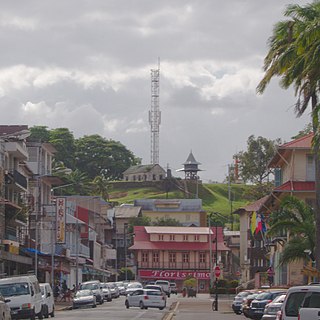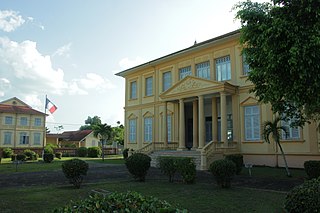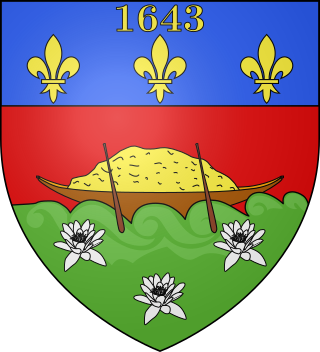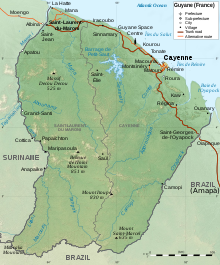
Cayenne is the prefecture of French Guiana, an overseas region and department of France located in South America and its capital city. The city stands on a former island at the mouth of the Cayenne River on the Atlantic coast. The city's motto is "fert aurum industria", which means "work brings wealth". Cayenne is the largest Francophone city of the South American continent.
Air Guyane SP is a French-Guyanese airline with its head office on the grounds of Cayenne-Rochambeau Airport in Matoury, French Guiana, France. It operates regional scheduled flights. Its main base is Cayenne-Rochambeau Airport.

The Oyapock or Oiapoque is a 403-kilometre (250 mi) long river in South America that forms most of the border between the French overseas department of French Guiana and the Brazilian state of Amapá.

Saint-Laurent-du-Maroni is a commune of French Guiana, an overseas region and department of France located in South America. Saint-Laurent-du-Maroni is one of the three sub-prefectures of French Guiana and the seat of the Arrondissement of Saint-Laurent-du-Maroni. It is the second most populous city of French Guiana, with 50,250 inhabitants at the January 2021 census.

Saint-Georges is a commune of French Guiana, an overseas region and department of France located in South America. It lies on the Oyapock River, opposite the Brazilian town of Oiapoque. The town contains a town hall, a French Foreign Legion detachment, and some hotels. Saint-Georges has been one of the three sub-prefectures of French Guiana and the seat of the Arrondissement of Saint-Georges since October 2022.

Régina is a commune of French Guiana, an overseas region and department of France located in South America. With a land area of 12,130 km2 (4,680 sq mi), it is the second-largest commune of France. The town is named after the first merchant who settled in the area.

Camopi is a commune of French Guiana, an overseas region and department of France located in South America. Camopi is mainly inhabited by Amerindians of the Wayampi and Teko tribes.

The 3 arrondissements of the Guyane department are:
- Arrondissement of Cayenne, with 10 communes. The population of the arrondissement was 177,716 in 2019.
- Arrondissement of Saint-Laurent-du-Maroni, with 8 communes. The population of the arrondissement was 96,757 in 2019.
- Arrondissement of Saint-Georges, with 4 communes. The population of the arrondissement was 7,205 in 2019. This arrondissement was created by a government decree of October 26, 2022.

The arrondissement of Cayenne is an arrondissement of France in the French Guiana department in French Guiana region. It has 10 communes. Its population is 181,520 (2020), and its area is 17,029 km2 (6,575 sq mi). It is the smallest of the three arrondissements in French Guiana, but also its most populated.

Wayampi or Wayãpi are an indigenous people located in the south-eastern border area of French Guiana at the confluence of the rivers Camopi and Oyapock, and the basins of the Amapari and Carapanatuba Rivers in the central part of the states of Amapá and Pará in Brazil. The number of Wayampi is approximately 2,171 individuals. Approximately 950 live in French Guiana in two main settlements surrounded by little hamlets, and 1,221 live in Brazil in 49 villages.

Articles related to the French overseas department of Guiana(Région Guyane) include:

French Guiana is an overseas department and region of France located on the northern coast of South America in the Guianas and the West Indies. Bordered by Suriname to the west and Brazil to the east and south, French Guiana covers a total area of 84,000 km2 (32,000 sq mi) and a land area of 83,534 km2 (32,253 sq mi), and is inhabited by 295,385 people.

The Franco-Brazilian Binational Bridge spans the Oyapock River, linking the cities of Oiapoque in Amapá, Brazil and Saint-Georges-de-l'Oyapock in French Guiana, France. The bridge is cable-stayed, with two towers rising to a height of 83 metres (272 ft) and a length of 378 metres (1,240 ft). There are two lanes for vehicles with a total width of 9 metres (30 ft) and a pedestrian sidewalk with a width of 2.50 metres. The vertical clearance under the bridge is 15 metres (49 ft).
Camopi Airport is an airport serving the Oyapock river village of Camopi, French Guiana near the border with Brazil.
Sainte-Rose-de-Lima is a village of Lokono Amerindians in the commune of Matoury in French Guiana. The village is located on the RN2 near Cayenne – Félix Eboué Airport. It is the largest settlement of Lokono in French Guiana.

Route nationale 1 (RN1) is a highway in French Guiana, an overseas region and department of France in South America. The highway connects Cayenne with Saint-Laurent-du-Maroni and measures 258 kilometres (160 mi). The highway is the busiest road of French Guiana.

Route nationale 2 (RN2) is a highway in French Guiana, an overseas region and department of France in South America. The highway connects Cayenne with Saint-Georges and measures 185 kilometres (115 mi). The highway provides a direct connection to Brazil.
As of 2018, there are 440 kilometres of national roads, 408 kilometres of departmental road, and 1,311 kilometres of municipal roads in French Guiana. There is no motorway.



















